Types of fishing hooks include J-hooks, circle hooks, treble hooks, double hooks, siwash hooks, Aberdeen hooks, and bait holder hooks. Each type serves a specific purpose, such as improving hooking rates, preventing gut hooking, or holding bait securely, and is suitable for different fishing techniques and species.
Selecting the best-sized fishing hook for your target fish species and having high-quality steel is one of the best decisions you can make to catch more fish.
I can’t count the fish I lost due to using the wrong size and getting my hook straightened from low-quality steel. It is an experience I don’t want to repeat again. That is why I always put a lot of effort into selecting the best possible fishing hook for the situation.
This article is designed to answer all of your fishing hook questions – from the different sizes available and the different types of hooks. By the end of this article, you should have a much better understanding of which hooks you should be using.
Table of Contents
Understanding Fishing Hook Sizes
Hook sizes are famously confusing. This is because they initially start with a high number with reducing numbers indicating larger sizes, but when you reach size #1, it reverses and larger numbers indicate larger sizes.
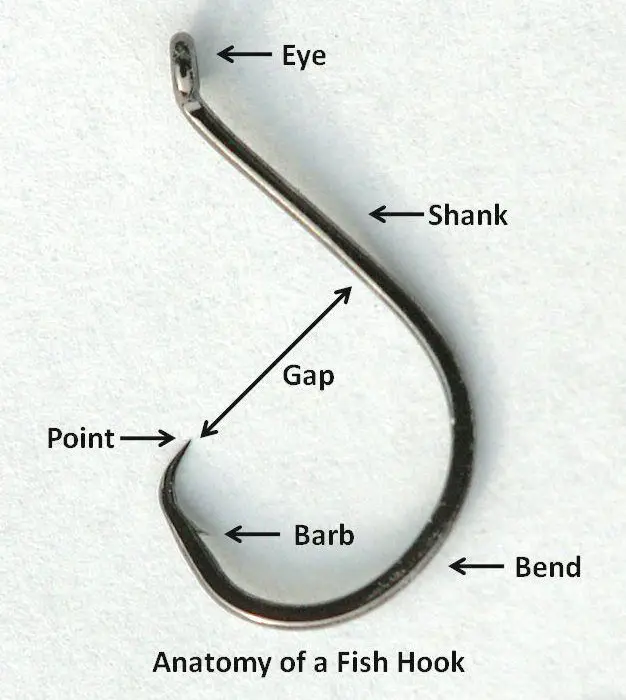
It can be confusing but there are a few ways you can simplify it to make sense by splitting the numbering system into freshwater and saltwater hooks.
Size Chart
| Hook Size | Shank Length (in) | Gap Width (in) | Total Length (in) |
|---|---|---|---|
| 32 | 0.19 | 0.09 | 0.31 |
| 30 | 0.25 | 0.11 | 0.38 |
| 28 | 0.31 | 0.13 | 0.44 |
| 26 | 0.38 | 0.16 | 0.50 |
| 24 | 0.44 | 0.19 | 0.56 |
| 22 | 0.50 | 0.22 | 0.63 |
| 20 | 0.56 | 0.25 | 0.69 |
| 18 | 0.63 | 0.28 | 0.75 |
| 16 | 0.69 | 0.31 | 0.81 |
| 14 | 0.75 | 0.34 | 0.88 |
| 12 | 0.81 | 0.38 | 0.94 |
| 10 | 0.88 | 0.41 | 1.00 |
| 8 | 0.94 | 0.44 | 1.06 |
| 6 | 1.00 | 0.47 | 1.13 |
| 4 | 1.06 | 0.50 | 1.19 |
| 2 | 1.13 | 0.53 | 1.25 |
| 1 | 1.19 | 0.56 | 1.31 |
| 1/0 | 1.25 | 0.59 | 1.38 |
| 2/0 | 1.31 | 0.63 | 1.44 |
| 3/0 | 1.38 | 0.66 | 1.50 |
| 4/0 | 1.44 | 0.69 | 1.56 |
| 5/0 | 1.50 | 0.72 | 1.63 |
| 6/0 | 1.56 | 0.75 | 1.69 |
| 7/0 | 1.63 | 0.78 | 1.75 |
| 8/0 | 1.69 | 0.81 | 1.81 |
| 9/0 | 1.75 | 0.84 | 1.88 |
| 10/0 | 1.81 | 0.88 | 1.94 |
Freshwater Fishing Hooks
Most anglers refer to size #1 hooks and smaller as being freshwater hooks and size #1/0 and larger as saltwater hooks.
The smallest hook you would ever consider is a size #22 hook, which is tiny and is used for tying flies. As the size goes down the hook gets larger – up to a point! When you get to a size #1 hook, it begins to reverse and larger numbers become larger hooks.
The smallest fishing hooks are designed for smaller fish who feed on smaller bait.
Saltwater Fishing Hooks
Once you get to a size #1 hook, then the next size up is a size #1/0 hook, then a size #2/0 hook, and so on. This can become confusing very quickly.
Larger fishing hooks are designed for large fish that can bend or break a smaller hook due to their immense power. The bigger fish can straighten a small hook if you haven’t selected a strong enough option.
The largest hook is a size #10/0, which is suitable for larger fish, big game fish and sharks.
Fishing Hook Size Species Chart
The size of hook you choose should be based on the size of your bait first and the size of your target species second, but we have made some simple recommendations to get you started.
| Hook Size | Purpose | Suitable Target Species |
|---|---|---|
| 32-20 | Micro fishing, live bait, and ice fishing | Small Panfish, Minnows |
| 18-14 | Ultralight freshwater fishing | Panfish, Small Trout, Bluegill |
| 12-10 | Light freshwater fishing | Panfish, Trout, Bluegill, Perch |
| 8-6 | Medium freshwater fishing | Bass, Crappie, Walleye, Catfish |
| 4-2 | Medium-heavy freshwater and light saltwater fishing | Bass, Walleye, Redfish, Snook |
| 1-1/0 | Heavy freshwater and medium saltwater fishing | Largemouth Bass, Catfish, Tarpon |
| 2/0-4/0 | Heavy saltwater fishing, large baits | Striped Bass, Snapper, Grouper |
| 5/0-7/0 | Heavy saltwater fishing, large baits | Amberjack, Cobia, Kingfish |
| 8/0-10/0 | Heavy saltwater fishing, large baits | Tuna, Marlin, Shark, Giant Trevally |
| 11/0-14/0 | Extreme saltwater fishing, large baits, big game fishing | Tuna, Marlin, Shark, Giant Trevally |
| 15/0+ | Extreme saltwater fishing, large baits, big game fishing | Tuna, Marlin, Shark, Giant Trevally |
The final comment on fishing hook sizes is that different manufacturers will have slightly different shank lengths even when comparing the same hook size. Keep this in mind when looking at which hook to buy.
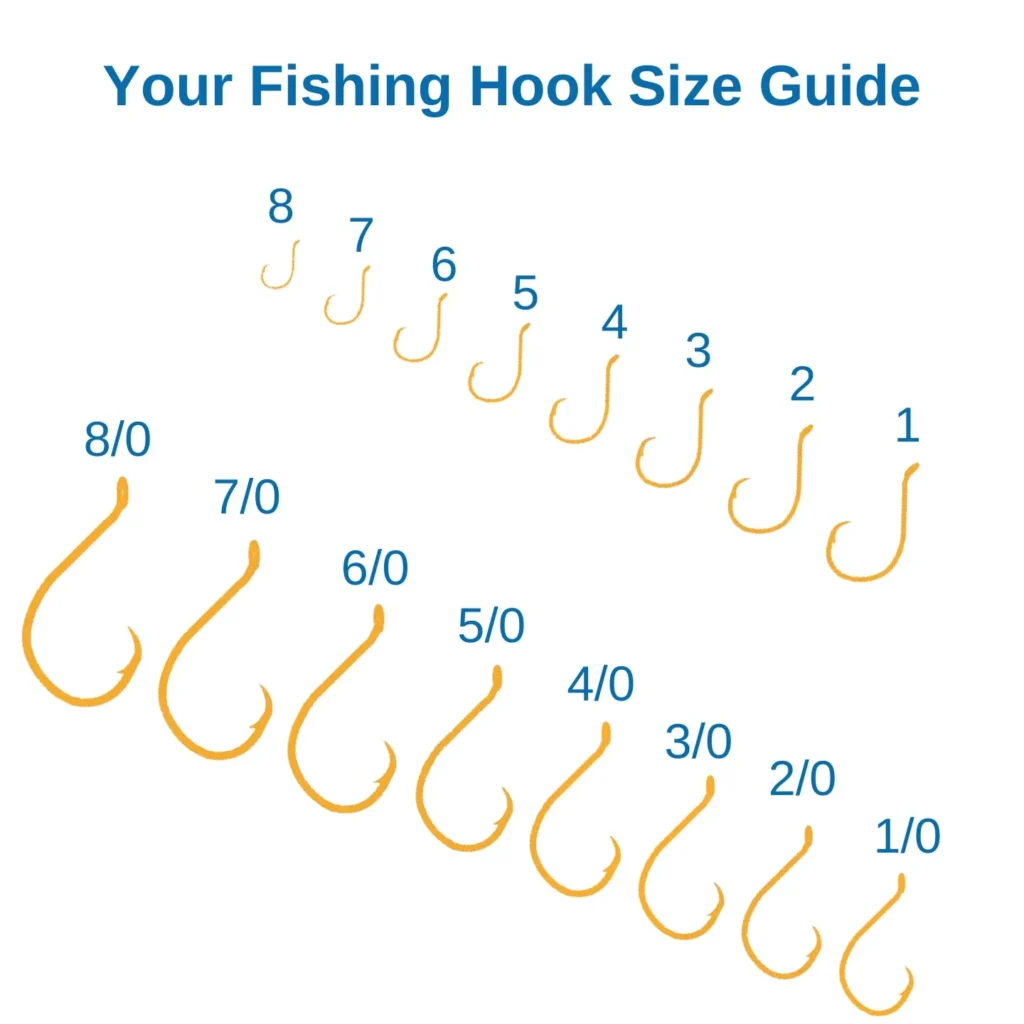
This video by BadAngling gives a great overview of the different fish hook sizes and shows the different shank lengths and gaps.
Barbed vs Barbless Hooks
Another difference between hooks is whether they contain a barb on the end of the hook. The advantage of the barb is that the hook is much more likely to get stuck in the fish’s mouth, although they have fallen out of popularity over recent years.
Many locations have banned the use of barbed hooks because they cause more damage to a fish during removal even when catching and releasing. In these locations, you are forced to use a barbless hook.
Barbed hooks also take a long time to rust away if the line breaks and the hook gets left in the fish’s mouth. Stainless steel hooks will take a very long time to corrode away, so be extremely careful when using a stainless steel barbed hook.
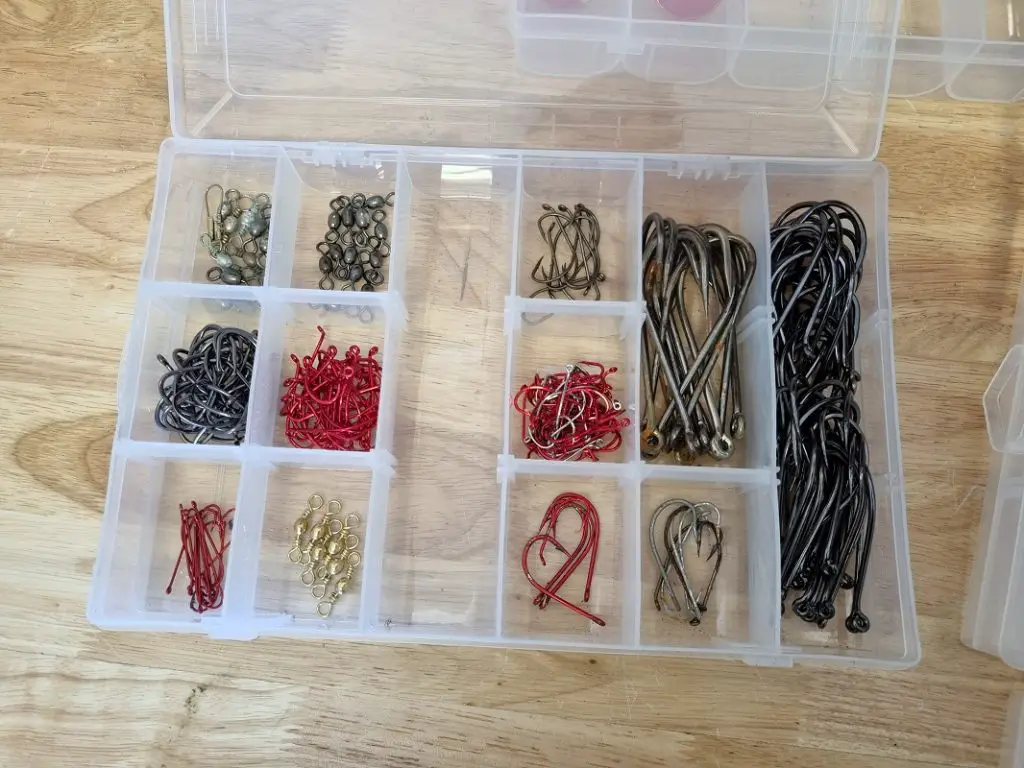
Types of Fishing Hooks
| Hook Type | Recommended Uses |
|---|---|
| J-Hook | General purpose, suitable for a variety of bait types and fishing styles (e.g., live bait, cut bait, and trolling) |
| Circle Hook | Catch-and-release fishing, live bait fishing (less gut-hooking, hooks fish in corner of mouth) |
| Treble Hook | Lure fishing (e.g., crankbaits, spinners, spoons), for attaching soft baits like dough balls for catfish |
| Worm Hook | Soft plastic worm baits and other soft plastics, used in bass fishing (e.g., Texas rig, Carolina rig) |
| Octopus Hook | Live bait and cut bait fishing, good for salmon, steelhead, and walleye |
| Siwash Hook | Single-hook replacement for treble hooks on lures, good for salmon, steelhead, and other larger species |
| Aberdeen Hook | Light-wire hook for live bait fishing, ideal for targeting panfish, crappie, and other smaller species |
| Kahle Hook | Live bait and cut bait fishing, good for catfish and larger panfish, allows for easier hook removal |
| Wacky Hook | Specifically designed for wacky rigging soft plastic worms and stick baits in bass fishing |
| Drop Shot Hook | Used for drop shot rigs in bass fishing, allows for a more natural presentation of soft plastic baits |
| Weedless Hook | Hooks with wire weed guards, designed for fishing in heavy cover and vegetation without getting snagged |
1. Bait Hook
Bait hooks (or a baitholder hook) are the most commonly found hook type. They often have barbs attached to the shank to help keep the bait in place.
They are extremely versatile and can be used for most types of fishing. You should certainly have a variety of bait hook sizes in your tackle box at all times.
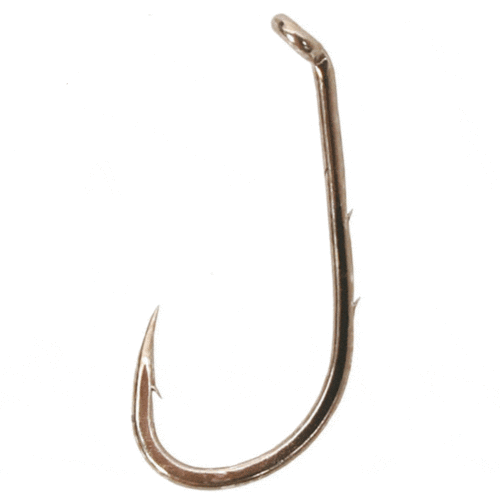
Advantages
Small barbs attached to the hook shank help to keep your bait in place. Using a bait hook means you will lose less bait to fish nibbles or hitting structures.
Disadvantages
The barbs can do a lot of damage to the fish when swallowed whole and when removed from deep in the fish’s gut. You should only use a bait hook when you intend on eating your catch.
When to Use a Bait Hook?
A bait hook is a popular type of fishing hook and should be used when using bait and not following catch and release. They are very versatile and can be used in most situations. A good example is a Carolina rig with a bobber.
2. Circle Hook
Circle hooks are easy to identify based on their shape. They have become increasingly popular in recent years and are mostly used with live bait.
The circle shape means the hook is unlikely to accidentally hook the fish deep in their gut and will only strike on the inside of their lip. Circle hooks are very popular in fishing competitions.
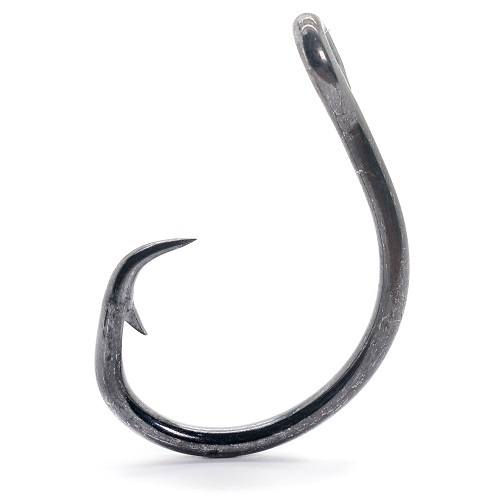
Advantages
A circle hook reduces the risk of gut hooking deep inside a fish. This means the fish will be healthy especially if you are intending on catching and releasing.
Disadvantages
You cannot strike when the fish bites as you will pull the hook out of the fish. Instead, you have to apply a steady pressure to keep the hook in the side of the fish’s mouth.
When to Use a Circle Hook?
You should use a circle hook when fishing with live bait when the well-being of the fish is paramount.
3. Treble Hook
Treble hooks have three hooks in the one package as the same suggests. They are primarily used for lures, crankbaits, or jerkbaits.
Some poor-quality lures come with poor-quality treble hooks and you will want to change them out before using them. It is always wise to keep an extra treble fishing hook in your tackle box.
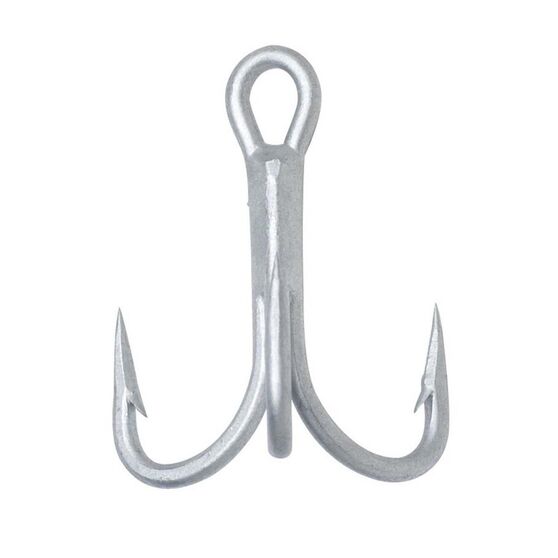
Advantages
It does not matter from which direction the fish bites your lure, one of the treble’s hooks will be pointing the right way.
The treble hooks are also very strong and are more suited for large, powerful fish.
Disadvantages
Not particularly versatile and are banned in some locations. Check with your local authorities about whether you can use a treble hook.
Treble hooks can also be difficult to remove as the second hook point can jab the fish the instant the first one is released.
When to Use a Treble Hook?
Treble hooks are used primarily when attached to hard body lures or crankbaits.
4. Octopus Hook
Octopus hooks have a curved shank which is on the short side. They are primarily used when bait fishing. Due to their short nature, they have a very low weight when compared to the other options. They are also called a J Hook.
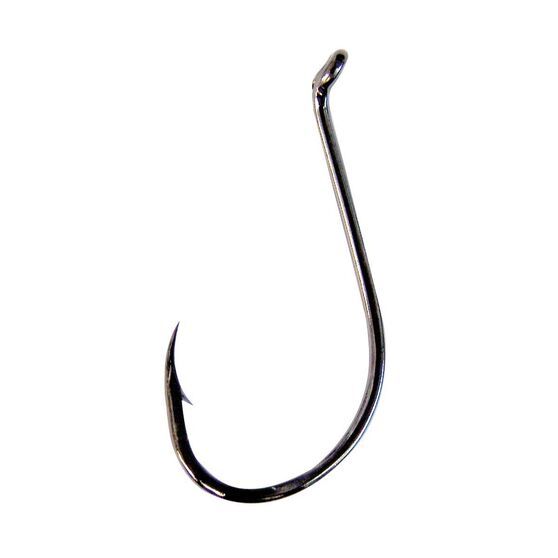
Advantages
Low hook weight and smaller size. Octopus hooks present the bait more naturally as there will be less steel visible.
Disadvantages
They are similar to a circle hook in that the hook can be pulled out of the fish’s mouth if you strike too heavily. You will need to adjust your striking technique accordingly.
When to Use an Octopus Hook?
Bait fishing when using worms, leeches, and maggots
5. Jig Hook
Jig hooks have their eye set at 90 degrees to the shank which allows the lure to move through the water.
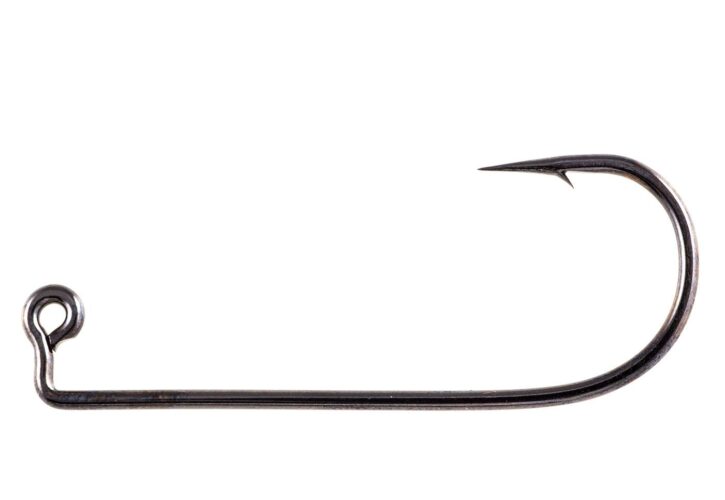
Advantages
They provide the most effective design to attach a hook to a plastic jig or lure. This gives the lure maximum movement and attracts more fish.
Disadvantages
Jig hooks are not very versatile.
When to Use a Jig Hook?
Jig hooks are exclusively used when attached to a lure or jig.
7. Weedless Hook
A weedless hook has a plastic weed guard which is attached from the hook to its point. This is designed to prevent light weed from getting snagged onto the point while being flexible enough that a fish will be able to bite past it.
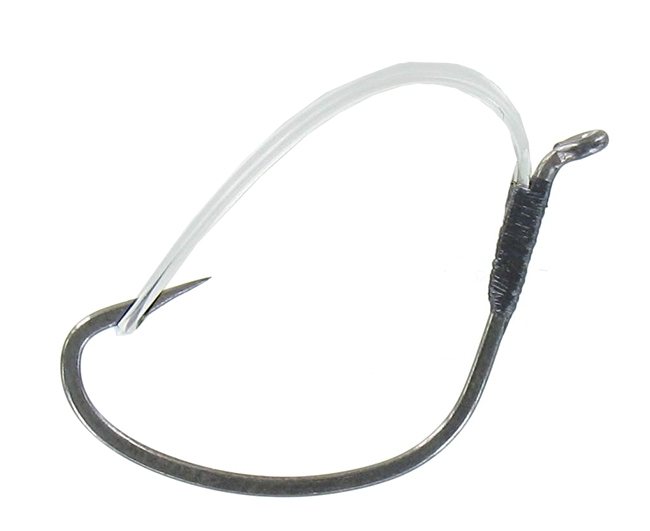
Advantages
Less likely to get covered in weed when fishing around weed beds, seaweed, or seagrass areas.
Disadvantages
It can be a bit more annoying to fish with as you may have to re-attach the weed guard if it gets dislodged after casting.
When to Use a Weedless?
Weedless hooks are a favorite for bass fishing and should be used when fishing in lakes with heavy vegetation.
Conclusion
For such a simple topic, there is a lot to know about fishing hooks. There are dozens of other types of hooks that we haven’t even mentioned like egg hooks, mosquito hooks, offset shank hooks, siwash hook, kahle hook, or aberdeen hook – but these are for more specialist types of angling.
For a beginner, you will likely be able to narrow down your hook purchase to the most popular styles and three different sizes to give you enough flexibility while on the water.
If you have any wisdom to share from your own experience then please leave a comment below – we are always keen to hear from our readers and learn from you.
What is your favorite hook?
Happy fishing!
